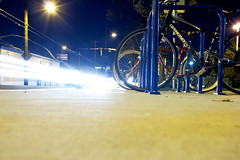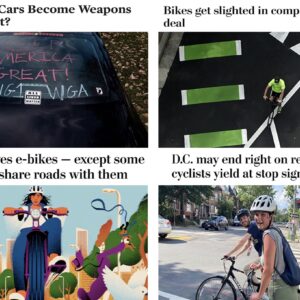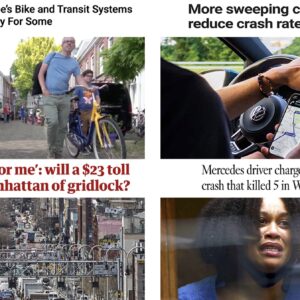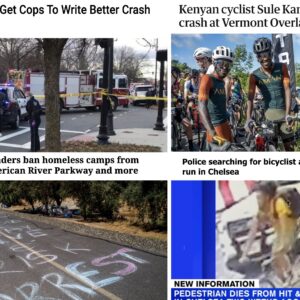
with a little “urban hacktion.”
(Photo: Will Vanlue/BikePortland)
Here’s the news and other cool stuff that caught our eyes this past week…
– An “expert cyclist” was struck by a 17-year-old driving a car in Bethlehem, PA. When the teen tried to flee the scene his escape was stopped by a quick-thinking bus driver and another witness to the crash.
– A man riding a bicycle in San Francisco allegedly plowed into a crowd of pedestrians, causing the death of a 71-year-old, then later took to the internet to confess the details of the crash.
– Seattle’s Bill Nye the Science Guy thinks the city of the future will be a bike-friendly one, including “bicycle arterials” that protect people on bikes from weather and propel them with artificial tailwinds.
– Evanston, IL (a suburb north of Chicago) is getting its own protected bike lane to connect its downtown to the lakefront.
– Politifact Oregon looked into a statement made by light rail booster and mayoral candidate Charlie Hales that streetcars beat buses in ridership, capacity, and cost. Their conclusion? He’s right.
– Washington County was recently ranked as the second healthiest county in Oregon coming in behind Benton and ahead of Clackamas (4th) and Multnomah (14th) Counties.
-Tom Vanderbilt took to Twitter to see if there really are people stuck in traffic on the way to ride a stationary bike, as Earl Blumenauer has famously suggested (turns out there are!).
– Brompton is showing “an increased level of confidence” in the market for folding bikes in North American and they’ve opened a new office right here in Portland.
– Another major bike brand headquartered in Portland, Rapha, was the subject of an article in The Oregonian’s ‘Playbooks and Profits’ column. The story chronicles Rapha’s rise, current success, and outlook for the future.
– One mom discovered how a few supervised, controlled, very low speed crashes can be a useful educational tool.
– People on bikes in Pennsylvania can breathe a little easier now that a state law requires people in motor vehicles to give at least four feet when passing.
– The “bike contingent” in San Diego, CA is becoming more active in local politics and candidates are beginning to pay attention.
– Stephanie Edman from Sweatpea Bicycles helped Treehugger address the question: “Are female city cyclists’ vulvas at risk?”
– Breaking traffic laws on a bicycle is monkey business in this short film from 1952 (the monkey gets on a bike around the 2-minute mark).
– A computer scientist introduced a new wireless braking system that “works with 99.9999999999997 percent reliability.”
– Two “urban hacktions” show how to turn bike parking into an outdoor chair or a make-shift gym.
– The City of Minneapolis released two PSAs explaining how to ride and drive on streets with new pavement markings. Check out their take on shared bike lanes in the video below:
– This week’s dose of Netherlands-envy comes via video from Hertogenbosch. It shows 25 low-stress crossings for people on bikes highway over one major highway…
– And finally, check out this amazing photo of what appears to be a praying mantis riding a tiny green bicycle (found via Popperfont):
Did you find something interesting that should be in next week’s Monday Roundup? Drop us a line. For more great links from around the web, follow us on Twitter @BikePortland.





Thanks for reading.
BikePortland has served this community with independent community journalism since 2005. We rely on subscriptions from readers like you to survive. Your financial support is vital in keeping this valuable resource alive and well.
Please subscribe today to strengthen and expand our work.
Just to clarify, streetcars beat buses in *operating* cost, not the large capital cost. But Charlie’s clear on that in his statements — streetcars are an issue he’s a national expert in.
Busses get to use roads funded partially by local property taxes, and occasionally highways funded by federal gas taxes that they don’t pay. Even with this, high capacity light rail lines do pay for themselves when a long payback period is used (50+ years). The east side max line has already been in operation for over 30 years.
25 years, not 30. Eastside MAX opened in 1986.
RE: The press release on Brompton opening up a new Portland office.
The press release states:
“The new office boasts a meeting room, a workspace for wrenching, storage and a comfortable office area. The icing on the cake is that when the rain finally stops, the front glass gate can be rolled back to give them a street café-style working environment.”
Yeah…I’m jealous…
Having windows that open for some fresh air during the summer at my office would be so fantastic. I too am a bit jealous!
Great video. My takeaways: the crossings are wide, smooth, separated, signed, and (where needed) signalized.
Very nice PSA from Minneapolis, especially showing how the bike boulevards are parallel alternatives to arterials. Love the Hertogenbosch video – shows all ages cycling, no helmets needed.
That Minneapolis video highlights the confusing uses of green.
What does the color mean? In a lane with sharrows, it’s the indicator of shared lanes. At the same time, it’s also marking bike lanes and bike boxes (Rose Quarter TC for a good example). So sometimes it’s exclusive, and sometimes it’s inclusive, but most of the time it’s not there at all when bikes are present.
I guess what I’m saying is that I don’t like inclusive green. Sharing is the DEFAULT condition on city streets.
Why would you use the word “allegedly” on that horrible story of the 71-year-old man that was killed by the cyclist? He was struck by the cyclist, just like the cyclist was struck by the driver in the story above, where you didn’t use the word “allegedly.” His own lawyer is saying he rode through the group of pedestrians and struck the pedestrian, but that it was an accident.
I used it only because the authenticity of his online admission wasn’t verified when I wrote the Roundup. It wasn’t meant to absolve anyone of the guilt of the crash itself.
Ok, thank you for acknowledging that. Seeing as this was showing up as Monday news, and he was admitting this through his lawyer as early as Friday, the use of the word concerned me. Guess we read different news sites. 😉
Regarding the discussion in comments below, whether something is on video or not doesn’t matter in this case, as his admission nulls the ‘alleged’ factor.
“Alleged” is journalist-speak for not having been convicted in trial.
I’m willing to guess that this spurs form the journalistic ethics code element “Balance a criminal suspect’s fair trial rights with the public’s right to be informed.” -Society of Professional Journalists Code of Ethics.
Will Vanlue is (probably) using this word to remove his possible judgement in the case in the chance that it would influence the outcome of a trial.
That only makes sense if he uses allegedly for every story in which a person has not yet been convicted, which isn’t the case because he doesn’t use allegedly in the story above it. I have to admit I too thought the use of “allegedly” was out of place, and am bothered by its use. It should either be used consistently or not used at all.
The above story, though, had video available. The SF story only has the words posted on the internet. I think there’s a reasonable difference here, whether the driver in PA is convicted or not, there is evidence of the driver hitting a cyclist. Video evidence taken by a CCTV with no subjective point of view. Regardless of the situation it’s been shown time and time again, eye witness evidence isn’t as water tight as it would seem. http://agora.stanford.edu/sjls/Issue%20One/fisher&tversky.htm
In this case I would have to give Will a pass.
It is interesting to think about. I also had an emotional reaction to reading “alleged.” In everyday conversation, I wouldn’t use that word unless I doubted the reliability.
However, in news media, there a paradigm of removing an author’s implicit judgment unless writing an explicit opinion piece. Objectivity is difficult to impossible given that any collection of information that is chosen to be presented conveys a representation of the beliefs of the author. Being a perceptive sort, we (humans) tend to spot this.
Champs, the video may not show this very well, but the sharrow lanes (Bryant Ave S being a good example) use a somewhat darker, very muted green, whereas the exclusive bike facilities are a much brighter green like we use for exclusive bike pavement in Portland. I agree that that multiple meanings of green could potentially be confusing, and on my last visit there back in November (Bryant had just gotten the green treatment) I was initially startled to see green on a shared lane. But that was mostly from a transpo-geek perspective … in practice, the two greens are so far apart that I think it is less of a problem than it might seem from watching the video.
Where I think it might be more confusing is that as of my last visit, some routes had the darker-muted-green treatment, but many (the E 40th Blvd, for example) did not. Hopefully the city is in the process of retrofitting the remaining blvds to green, though I don’t know that for a fact.
“-Tom Vanderbilt took to Twitter to see if there really are people stuck in traffic on the way to ride a stationary bike, as Earl Blumenauer has famously suggested (turns out there are!).” <– This link is one of the most awesome things I've read in a while.
Re: Bill Nye's video, I love the idea of having a tailwind both directions. Of course the engineer in me wonders about the energy consumption, but a constant tailwind is the ultimate cycling fantasy, isn't it? OK, except on hot days when you're riding up hill … hey, while we're dreaming can we get a tunnel under the West Hills already? That could shave 15 minutes off the trip to Beaverton.
Re BRT vs. Streetcars. My feeling is that Hales is wrong on all three criteria. He’s bending spoons to get the analysis to go his way. Want commuters to get out of their car, give them a fast, comfortable ride. Streetcars aren’t made for commuting. And the current trimet buses are SOOO uncomfortable. No wonder noone wants to ride them.
I know several people that commute by streetcar. It may not work for your needs, but it does for many.
The finances of Portland Streetcar, Inc., are not available for us to see, although they probably should be under Oregon’s public records law.
Until Michael Powell, founder and operator of Portland Streetcar, Inc., ends his secretive ways, Charlie Hales is just blowing smoke on costs.
By the way, just what are the relationships of Chris Smith and Charlie Hales to Portland, Streetcar, Inc., and have they been compensated in any way for their many years of service to its cause?
I have always like bill nye, speed walker and cycling advocate. What’s not to like?
that poor monkey… cut off by a driver backing out of a driveway and totally made out to be the monkey’s fault when it was clearly the driver not looking where they were going… they even got the police involved for it and it was STILL the monkey’s fault… some things never change…